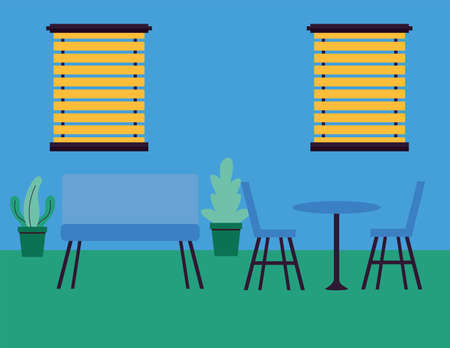Introduction to Biophilic Design
In recent years, biophilic design has become a prominent movement across the UK, echoing a broader shift towards well-being and sustainability within our built environments. Rooted in the innate human affinity for nature, this approach brings elements of the natural world into interior spaces, aiming to foster a sense of tranquillity and connection even in the heart of bustling cities. As more people recognise the impact of their surroundings on mental health and overall wellness, British homes, offices, and public venues are embracing biophilic principles to create restorative settings that go beyond mere aesthetics. By weaving nature-inspired materials, organic forms, and living greenery into the fabric of our interiors, biophilic design not only uplifts mood but also enhances productivity and reduces stress. In this context, sustainable materials play a crucial role, supporting both environmental responsibility and long-term well-being—a combination that resonates strongly with contemporary British values.
Sustainable Materials in British Interiors
In the context of biophilic design, choosing sustainable materials is more than a trend—it’s a commitment to both environmental stewardship and cultural continuity. Within British interiors, several materials have become synonymous with eco-conscious design, each bearing its own unique story and significance. Let’s explore some of the most popular choices that are shaping homes and public spaces across the UK.
Reclaimed Timber: Echoes of Heritage
Reclaimed timber is a staple in British interior design, valued not just for its sustainability but also for its connection to the nation’s architectural past. Sourced from old barns, factories, or even decommissioned ships, this material brings an authentic sense of history into modern settings. Its weathered texture and patina offer visual warmth while reducing demand for newly harvested wood—a win for both nostalgia lovers and environmentalists.
Wool: Local Luxury with Low Impact
Wool, particularly British wool from breeds such as Herdwick or Cheviot sheep, is another celebrated material. The UK has a long-standing tradition of wool production, and using locally sourced wool supports rural communities while minimising carbon footprints associated with transport. Wool’s natural insulating properties make it ideal for rugs, upholstery, and textiles—creating cosy spaces that resonate with British comfort culture.
Locally Sourced Stone: Grounded in Place
From Cotswold limestone to Welsh slate, stone quarried within the UK lends interiors a grounded sense of place. These materials not only reflect regional character but also reduce the ecological impact of long-distance shipping. Their durability ensures longevity, making them a timeless investment in sustainable design.
Comparing Sustainable Materials: Environmental & Cultural Impacts
| Material | Environmental Impact | Cultural Significance |
|---|---|---|
| Reclaimed Timber | Reduces waste; prevents deforestation; low embodied energy | Preserves historical character; links to traditional craftsmanship |
| Wool (British) | Biodegradable; renewable; supports local farming economies | Celebrates national heritage; integral to rural identity |
| Local Stone | Lowers transport emissions; extremely durable; minimal processing required | Tied to regional landscapes; often featured in iconic architecture |
The Broader Context: Why Material Choices Matter
The use of these materials goes beyond mere aesthetics or environmental box-ticking. Each choice weaves together threads of British history, community, and responsible living—reinforcing biophilic design’s core principle: fostering harmonious relationships between people and nature within built environments.

3. Iconic British Examples of Biophilic Spaces
Britain boasts an array of architectural gems that artfully integrate biophilic principles, effortlessly weaving together the nation’s deep-rooted reverence for tradition with a progressive approach to sustainability. These exemplary spaces highlight how nature-inspired design can flourish within both historical and contemporary settings.
The Eden Project: Cornwall’s Living Laboratory
Perhaps no project encapsulates Britain’s commitment to biophilia quite like the Eden Project in Cornwall. Conceived as a celebration of biodiversity, its iconic geodesic biomes house thousands of plant species and create immersive environments that transport visitors from Mediterranean warmth to tropical rainforest. The structure’s innovative use of locally sourced materials and natural light not only exemplifies sustainable practice but also reimagines how public spaces can foster a connection between people and the planet.
Maggie’s Centre, Leeds: A Sanctuary in the City
Maggie’s Centres across the UK, designed by leading architects, provide cancer support in uplifting surroundings. The Leeds centre, designed by Heatherwick Studio, stands out for its undulating timber structure and verdant rooftop gardens, seamlessly blurring the boundaries between inside and out. Here, tradition is honoured through references to British garden culture, while innovation is found in the sustainable timber construction and abundant daylighting—a testament to how healing environments can be both nurturing and ecologically responsible.
Commercial Innovation: Bloomberg’s London Office
The Bloomberg European Headquarters in London sets new standards for workplace sustainability. Designed by Foster + Partners, this building integrates living walls, natural ventilation systems, and water features throughout its interior spaces. Employees benefit from leafy terraces with views of St Paul’s Cathedral, highlighting how modern offices can incorporate British heritage alongside forward-thinking green design.
Residential Retreats: Bringing Biophilia Home
Across the UK, private homes are increasingly embracing biophilic design—from Victorian townhouses retrofitted with sun-drenched orangeries to contemporary eco-homes built with reclaimed brick, clay plaster, and green roofs. In these dwellings, traditional craftsmanship meets modern ecological sensibilities: sash windows frame garden vistas, while interiors are finished with natural paints and tactile timbers sourced from British forests.
These diverse examples demonstrate that in the UK, biophilic design is not merely a passing trend but a meaningful evolution—one that honours heritage while pioneering a greener future. Through the harmonious marriage of time-honoured aesthetics and innovative materials, British spaces set a benchmark for bringing nature indoors in ways that are both beautiful and sustainable.
4. Cultural Connections: Nature and the British Lifestyle
The British relationship with nature is deeply rooted in both history and modern living, shaping how homes and public spaces are designed today. Traditionally, Britons have fostered a close bond with the outdoors through pursuits like allotment gardening, rambling across the countryside, and maintaining private gardens—an integral part of the national identity. This cultural affinity continues to influence contemporary design choices as biophilic design principles become more prevalent.
Historically, allotments emerged during the Industrial Revolution as a response to urbanisation, providing city dwellers with personal plots to grow food and reconnect with green spaces. Today, these humble garden patches remain treasured havens for urban Britons seeking solace from city life. Similarly, the long-standing tradition of countryside walks—whether along coastal paths or through rolling dales—reflects a collective appreciation for fresh air and scenic beauty. These practices are more than pastimes; they reveal a fundamental desire to integrate nature into daily existence.
Influence on Design Choices
This enduring connection to nature is mirrored in British interior design, where natural materials and elements are favoured not just for their aesthetic appeal but also for their emotional resonance. The popularity of sustainable timber floors, stone accents, and wool textiles stems from a collective memory of rural landscapes and traditional craftsmanship. Furthermore, contemporary designers often incorporate indoor plants, daylight maximisation, and organic forms as nods to the nation’s love of gardens and outdoor living.
Examples of Nature-Inspired Elements in British Design
| Biophilic Element | Historic Connection | Modern Application |
|---|---|---|
| Timber beams & wood panelling | Cottage architecture & woodland management | Sustainable FSC-certified wood interiors |
| Natural stone flooring | Quarrying traditions in regions like Yorkshire | Limestone or slate tiles in kitchens & halls |
| Indoor plants & greenery | Victorian conservatories & garden rooms | Living walls & potted herbs in kitchens |
| Wool textiles & soft furnishings | Sheep farming heritage (e.g., Cotswolds) | Bespoke rugs & throws from local makers |
| Large windows & skylights | Appreciation of changing British weather & views | Daylight-filled open-plan living areas |
The Emotional Impact of Biophilic Design on Britons
This interplay between culture and nature ensures that biophilic design resonates strongly with British sensibilities. By blending sustainable materials with elements that evoke cherished national pastimes—from tending an allotment to strolling through bluebell woods—designers create spaces that are both environmentally responsible and emotionally comforting. In essence, every choice reflects not only a commitment to sustainability but also a celebration of Britain’s enduring love affair with the natural world.
5. Practical Tips for Incorporating Biophilic Design at Home
Bringing the outdoors in isn’t just a design trend—it’s a lifestyle shift that can enhance wellbeing and foster sustainability, especially in the UK’s unique living environments. Here are some actionable tips tailored for British homes keen on embracing biophilic design principles:
Embrace Houseplants Suited to UK Homes
Start small with hardy, low-maintenance houseplants like English ivy, peace lilies, or spider plants—perfect for British interiors and adept at thriving even during gloomy winter months. Cluster plants at varying heights to create visual interest, or introduce a statement piece like a Kentia palm in your lounge. Don’t overlook native species; herbs such as rosemary or mint not only add greenery but also infuse your kitchen with fresh scents and flavours.
Maximise Natural Light the British Way
The UK is no stranger to overcast skies, so making the most of available daylight is key. Swap heavy curtains for sheer fabrics or classic wooden shutters that allow gentle light diffusion. Consider placing mirrors opposite windows to bounce daylight deeper into rooms, lending a brighter, more open feel typical of airy Georgian terraces. Skylights and glass doors are excellent investments if you’re renovating, especially in garden-facing extensions common in British homes.
Opt for Sustainable Furnishings
Select furnishings crafted from responsibly sourced materials such as FSC-certified timber, reclaimed wood, or recycled metal and glass—choices that echo Britain’s growing commitment to eco-friendly living. Seek out local makers or vintage shops for unique pieces that tell a story and reduce your carbon footprint. Upholsteries made from organic cotton, linen, or wool not only evoke natural textures but also add tactile warmth suited to cosy British interiors.
Create Nature-Inspired Zones
Dedicate a corner for relaxation with natural elements: perhaps a reading nook by the window adorned with leafy plants and tactile woven throws, or a dining area featuring a solid oak table set with stoneware crockery. These zones help cultivate mindful moments throughout the day—a nod to the slower pace often cherished in UK country living.
Layer Natural Materials and Colours
Draw inspiration from the British landscape: think soft greens reminiscent of rolling hills, muted blues echoing coastal skies, and warm neutrals reflecting Cotswold stone cottages. Layer these hues through cushions, rugs, and artwork. Introduce tactile materials like jute mats or woollen blankets to ground your space in nature’s palette while keeping things snug during chilly evenings.
By thoughtfully integrating these biophilic design strategies—rooted in both sustainability and an appreciation of Britain’s rich natural heritage—you’ll foster a healthier home environment that feels connected to the world outside your window.
6. Future Trends: The Evolution of Biophilic Design in the UK
As biophilic design continues to shape interiors across the UK, new trends and innovations are emerging that promise to deepen our connection with nature while pushing the boundaries of sustainability. A key development is the increasing integration of smart technology with natural elements, allowing for adaptive lighting systems that mimic circadian rhythms, automated green wall maintenance, and even responsive environmental controls that adjust temperature and humidity based on plant needs. These advancements not only enhance occupant wellbeing but also optimise energy use within homes and workplaces.
The Rise of Circular Economy Principles
Another defining feature of the next wave in British biophilic design is a commitment to circular economy principles. Designers and architects are moving beyond traditional recycling, prioritising materials that are upcycled, reclaimed, or fully biodegradable. Furniture crafted from locally sourced reclaimed timber, modular living wall systems designed for disassembly and reuse, and carpets made from recycled fishing nets are becoming mainstream choices. This ethos fits seamlessly with the UKs cultural emphasis on resourcefulness and sustainability, driving a shift from linear consumption patterns to regenerative practices.
Smart Nature: Technology Meets Green Living
The synergy between digital innovation and natural inspiration is particularly pronounced in urban developments. Smart sensors can monitor air quality and prompt ventilation when pollution levels rise, while app-controlled irrigation ensures optimal hydration for indoor plants without waste. Augmented reality features are also being explored to visualise how natural light will move through a space or how specific plant species will develop over time—making biophilic design more accessible and adaptable for both residential and commercial environments.
Community-Driven Green Spaces
A uniquely British trend is the growth of community-driven indoor gardens and shared biophilic spaces in apartment complexes, offices, and public venues. These projects foster social cohesion, support biodiversity, and promote mental health—values deeply rooted in UK culture. As these collaborative initiatives expand, expect to see more flexible green zones that respond to seasonal changes or local ecological needs.
Looking ahead, the evolution of biophilic design in the UK will be defined by its ability to harmonise cutting-edge technology with a reverence for nature’s cycles. By embracing smart systems and circular economy models, British interiors will continue to set benchmarks for sustainable living—proving that innovation and tradition can flourish side by side when it comes to bringing nature indoors.


